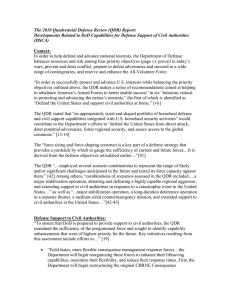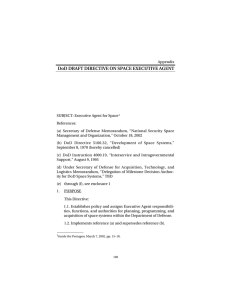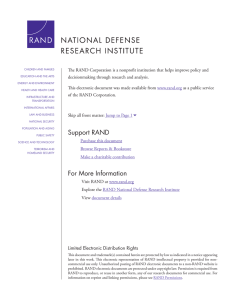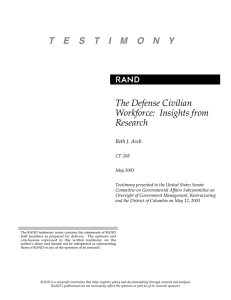1.1 DoD Space Planning Criteria for Health Facilities General
advertisement
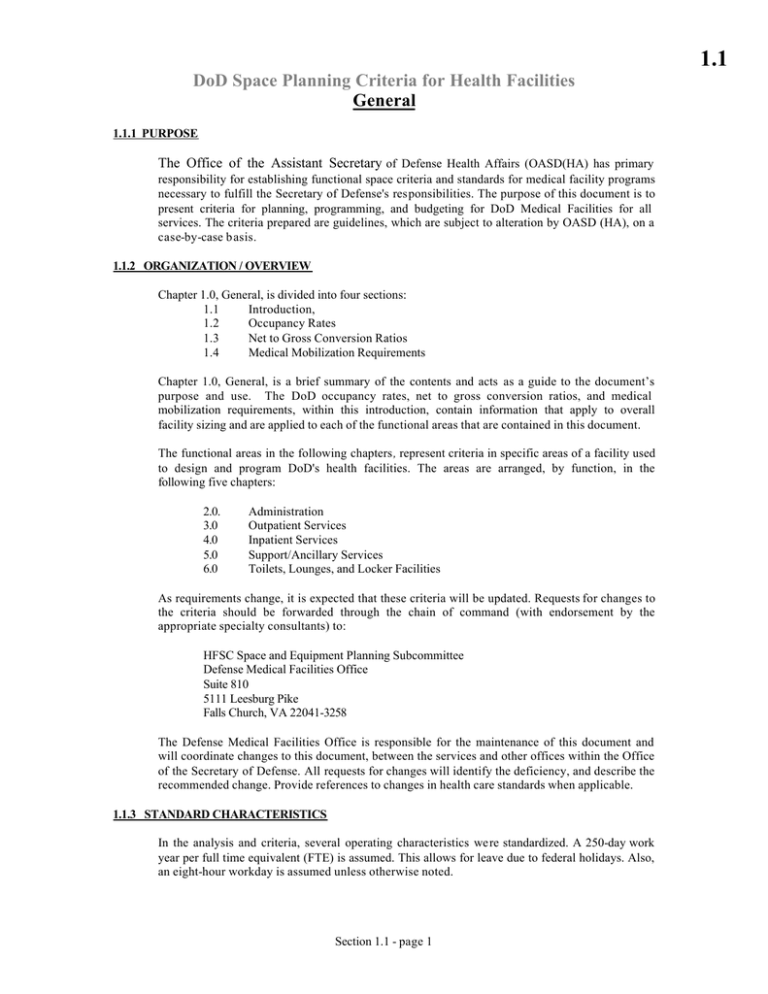
1.1 DoD Space Planning Criteria for Health Facilities General 1.1.1 PURPOSE The Office of the Assistant Secretary of Defense Health Affairs (OASD(HA) has primary responsibility for establishing functional space criteria and standards for medical facility programs necessary to fulfill the Secretary of Defense's responsibilities. The purpose of this document is to present criteria for planning, programming, and budgeting for DoD Medical Facilities for all services. The criteria prepared are guidelines, which are subject to alteration by OASD (HA), on a case-by-case basis. 1.1.2 ORGANIZATION / OVERVIEW Chapter 1.0, General, is divided into four sections: 1.1 Introduction, 1.2 Occupancy Rates 1.3 Net to Gross Conversion Ratios 1.4 Medical Mobilization Requirements Chapter 1.0, General, is a brief summary of the contents and acts as a guide to the document’s purpose and use. The DoD occupancy rates, net to gross conversion ratios, and medical mobilization requirements, within this introduction, contain information that apply to overall facility sizing and are applied to each of the functional areas that are contained in this document. The functional areas in the following chapters, represent criteria in specific areas of a facility used to design and program DoD's health facilities. The areas are arranged, by function, in the following five chapters: 2.0. 3.0 4.0 5.0 6.0 Administration Outpatient Services Inpatient Services Support/Ancillary Services Toilets, Lounges, and Locker Facilities As requirements change, it is expected that these criteria will be updated. Requests for changes to the criteria should be forwarded through the chain of command (with endorsement by the appropriate specialty consultants) to: HFSC Space and Equipment Planning Subcommittee Defense Medical Facilities Office Suite 810 5111 Leesburg Pike Falls Church, VA 22041-3258 The Defense Medical Facilities Office is responsible for the maintenance of this document and will coordinate changes to this document, between the services and other offices within the Office of the Secretary of Defense. All requests for changes will identify the deficiency, and describe the recommended change. Provide references to changes in health care standards when applicable. 1.1.3 STANDARD CHARACTERISTICS In the analysis and criteria, several operating characteristics were standardized. A 250-day work year per full time equivalent (FTE) is assumed. This allows for leave due to federal holidays. Also, an eight-hour workday is assumed unless otherwise noted. Section 1.1 - page 1 1.1 DoD Space Planning Criteria for Health Facilities General 1.1.4 SPACE PLANNING FRAMEWORK To guide and ensure consistent evaluation, a framework for space planning is proposed. The framework consists of the information listed throughout this document, and has been inserted into the Space & Equipment Planning System program of The Defense Medical Facilities Office. These guidelines, along with equipment requirements, help determine square footage listed in the Program for Design (PFD) through the use of the SEPS program. There are two stages to the proposed framework (there may be multiple levels of determination in each stage): Stage 1: Develop specific functional area space programs based on environmental inputs. Stage 2: Perform a readiness review of the resulting first stage space programs. This section presents this framework and considerations for each stage. Functional areas of planning are driven from a set of environmental inputs, through a set of space criteria leading to a functional area Program for Design. Within this framework, the environmental inputs are defined to indicate demand for space (e.g., program obligations, service requirements, staffing, activity, and equipment). The four major categories of space criteria are: administration, and support of administration. patient care, support of patient care, To determine the Program for Design, the environmental inputs are translated via a set of specific space criteria. Some of the issues undertaken during a readiness review (second stage) include: * Does the program provide appropriate space for mission accomplishment and for all personnel who will be working in the facility? One of the most common mistakes in the creation of a space program for a facility is to overlook one or more functions, which will be accomplished in the proposed facility. All too often reviewers of space planning documents focus on what is stated in the document and fail to look for that which was omitted. Insure that all services are included. Additionally, insure that space is provided for all workers in the facility. This includes assigned personnel (military and civilians), volunteers, contractors and borrowed labor. * Are there differences in the space criteria assumptions or operating characteristics that impact the numbers and sizes of units? For example, use of quick chill food preparation allows for more even distribution of work load which can lead to almost complete elimination of food preparation areas, reduction in the cook's line space, and reduction of storage space, but increase space requirements for remote food preparation alcoves. For example, the development and implementation of digital radiology imaging equipment will require additional space for the digital radiology equipment and computer control staff areas, while reducing film storage requirements. * Are environmental factors present that necessitate the support of a program not justified within the criteria? For example, obstetrical services are not justified where volumes are less than 250 deliveries per year. Section 1.1 - page 2 1.1 DoD Space Planning Criteria for Health Facilities General Remote facilities, which have an obstetrical requirement or where local community obstetrical standards are not up to US standards, may require that this service be provided. * Are environmental factors present that necessitate the support of a program not covered by the criteria? For example, teaching and research activities may currently warrant programming for interventional radiography. Location and access to this modality may prevent the use of local facilities. * Could services more appropriately be provided through alternative methods? For example, obstetrical requirements of less than 10 Average Daily Patient Load (ADPL) may be more economically met through other community providers * Is this an addition/alteration project? If so, then what allowance, if any, should be made in computing final area gross square feet? * Are there physical constraints on exterior walls that make the net to gross conversion factors unrealistic? For example, facilities in severe climates may be designed with thicker walls (for a larger amount of insulation) than in average climates. The additional wall thickness may be justified in order to lead to lower operating energy costs. Another example is small facilities that often have a proportionately smaller amount of space contained within the exterior walls, than larger facilities. * Is there potential for consolidation of staff support areas (e.g., lockers, waiting rooms, lounge or conference areas)? For example, operating practices may warrant certain groupings of activities that lead to consolidation and coordination of space. For example, medical staff in several clinical specialties operate through a group practice. Physical design can support this leading to configuration and sizing different than the results of the first stage of the proposed space planning framework discussed above. Facility programming is a dynamic process. The two stage space planning framework presented is designed to assure a sound rational defense for the scope of a facility design project as it moves through the budgeting, programming, design, and approval process. Section 1.1 - page 3






